Query API Endpoints
The Query API Endpoints feature allows you to create an API endpoint directly from any saved SQL query in the ClickHouse Cloud console. You'll be able to access API endpoints via HTTP to execute your saved queries without needing to connect to your ClickHouse Cloud service via a native driver.
Quick-start Guide
Before proceeding, ensure you have an API key and an Admin Console Role. You can follow this guide to create an API key.
Creating a saved query
If you have a saved query, you can skip this step.
Open a new query tab. For demonstration purposes, we'll use the youtube dataset, which contains approximately 4.5 billion records. As an example query, we'll return the top 10 uploaders by average views per video in a user-inputted year parameter:
with sum(view_count) as view_sum,
round(view_sum / num_uploads, 2) as per_upload
select
uploader,
count() as num_uploads,
formatReadableQuantity(view_sum) as total_views,
formatReadableQuantity(per_upload) as views_per_video
from
youtube
where
toYear(upload_date) = {year: UInt16}
group by uploader
order by per_upload desc
limit 10
Note that this query contains a parameter (year). The SQL console query editor automatically detects ClickHouse query parameter expressions and provides an input for each parameter. Let's quickly run this query to make sure that it works:

Next step, we'll go ahead and save the query:
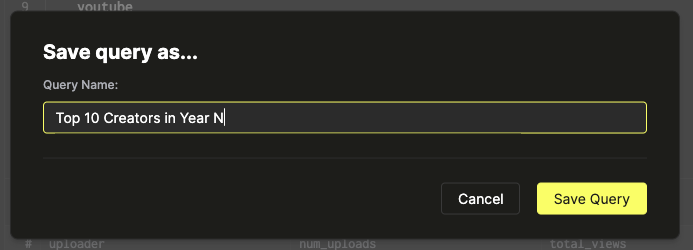
More documentation around saved queries can be found here.
Configuring the Query API Endpoint
Query API endpoints can be configured directly from query view by clicking the Share button and selecting API Endpoint. You'll be prompted to specify which API key(s) should be able to access the endpoint:
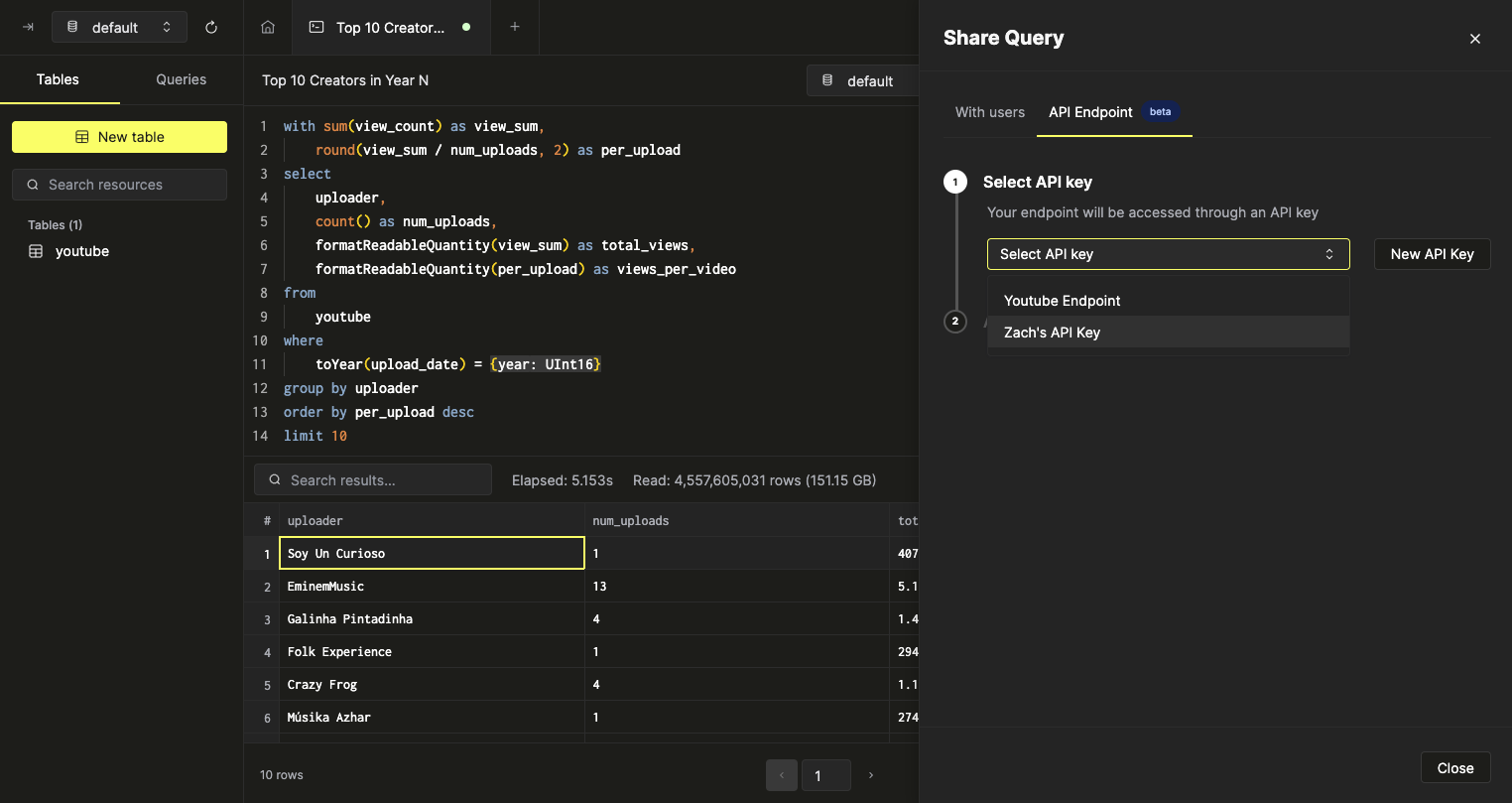
After selecting an API key, the query API endpoint will automatically be provisioned. An example curl command will be displayed so you can send a test request:
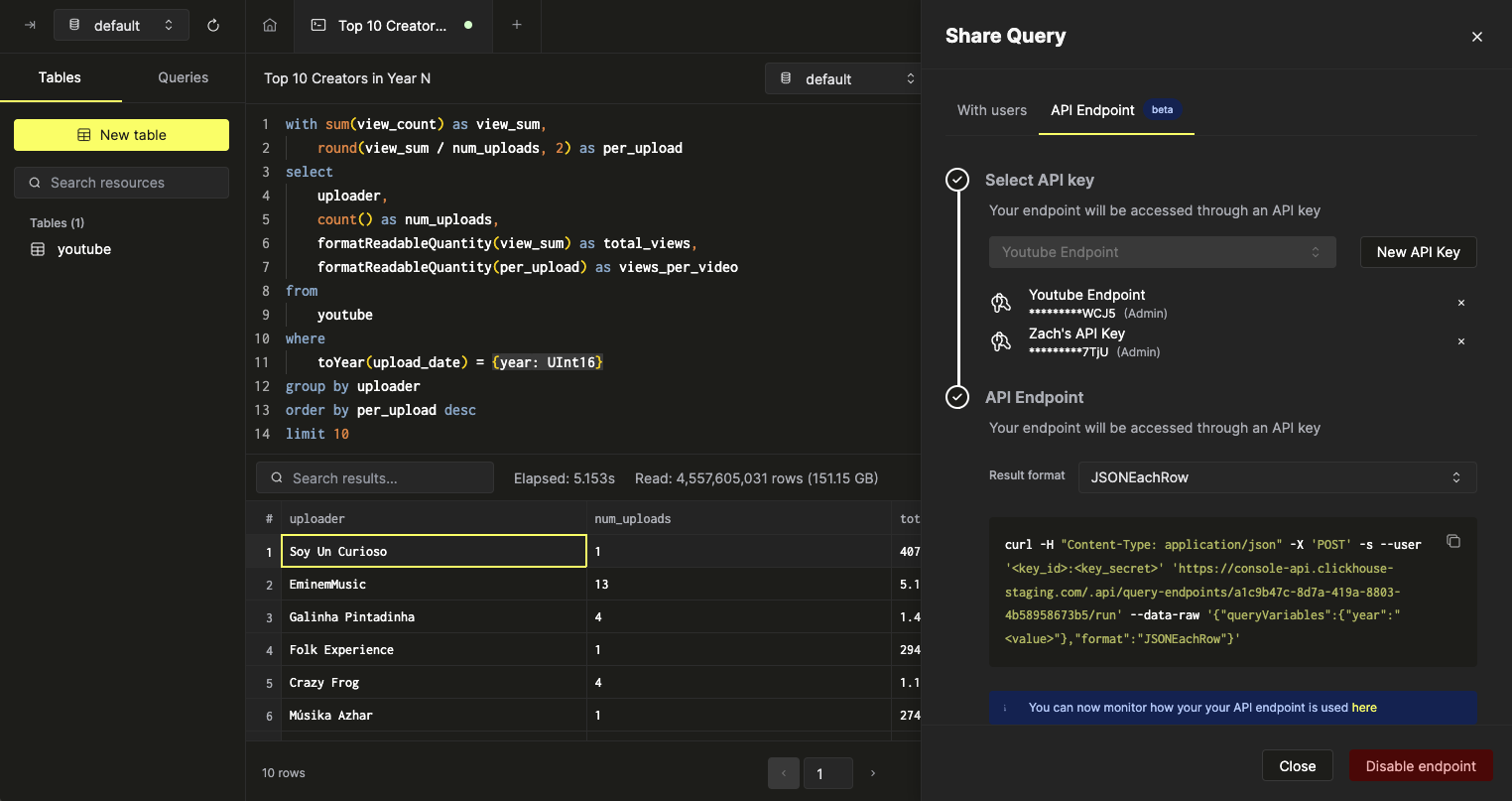
Query API parameters
Query parameters in a query can be specified with the syntax {parameter_name: type}. These parameters will be automatically detected and the example request payload will contain a queryVariables object through which you can pass these parameters.
Testing and monitoring
Once a Query API endpoint is created, you can test that it works by using curl or any other HTTP client:
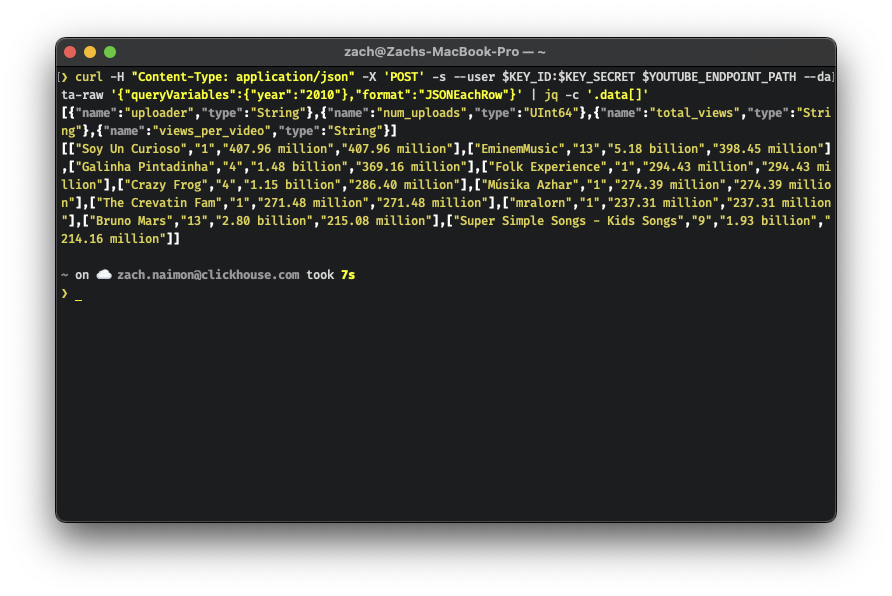
After you've sent your first request, a new button should appear immediately to the right of the Share button. Clicking it will open a flyout containing monitoring data about the query:
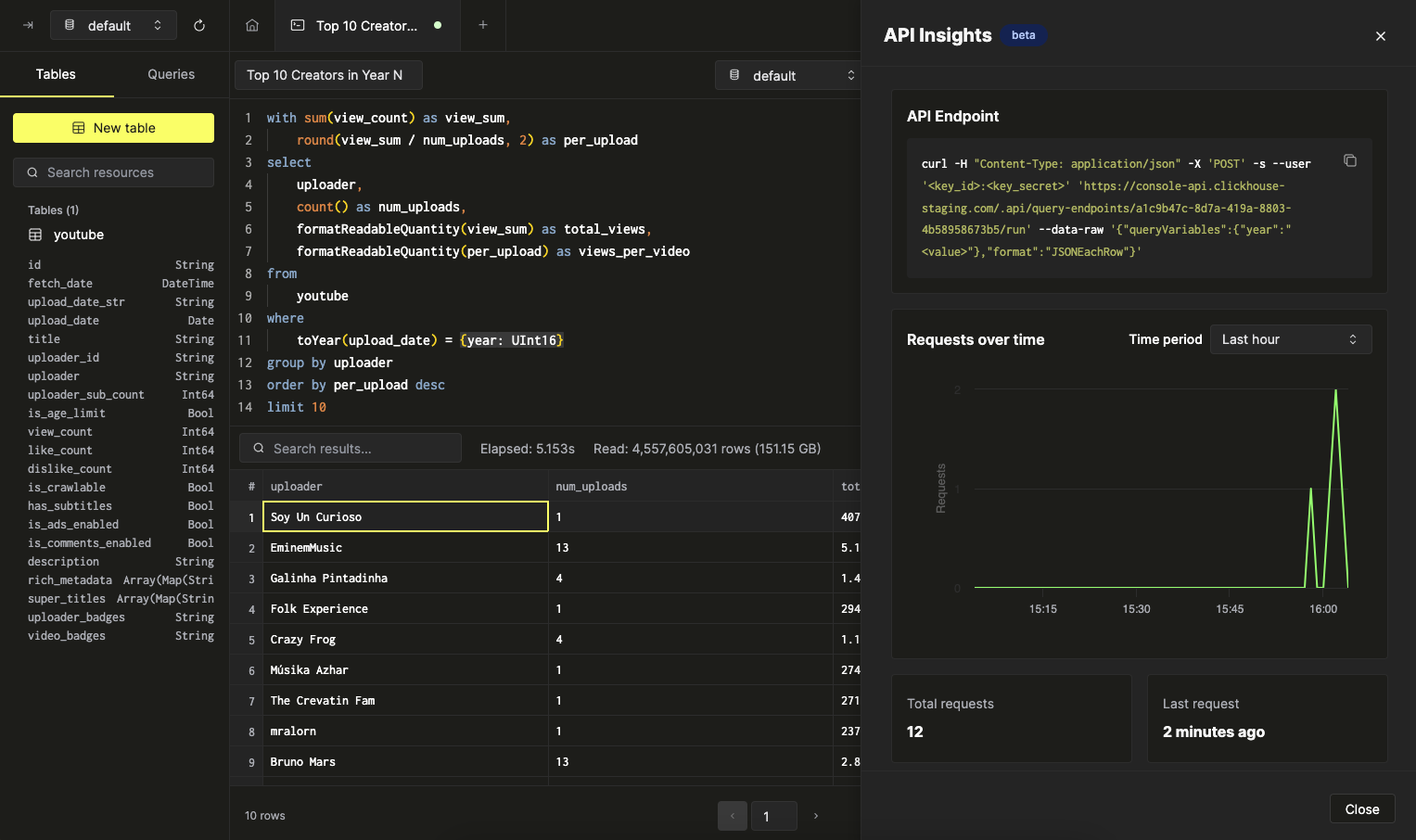
Implementation Details
Description
This route runs a query on a specified query endpoint. It supports different versions, formats, and query variables. The response can be streamed (version 2 only) or returned as a single payload.
Authentication
- Required: Yes
- Method: Basic Auth via OpenAPI Key/Secret
- Permissions: Appropriate permissions for the query endpoint.
URL Parameters
queryEndpointId(required): The unique identifier of the query endpoint to run.
Query Parameters
V1
None
V2
format(optional): The format of the response. Supports all formats supported by ClickHouse.param_:nameQuery variables to be used in the query.nameshould match the variable name in the query. This should only to be used when the body of the request is a stream.:clickhouse_settingAny supported ClickHouse setting can be passed as a query parameter.
Headers
x-clickhouse-endpoint-version(optional): The version of the query endpoint. Supported versions are1and2. If not provided, the default version is last saved for the endpoint.x-clickhouse-endpoint-upgrade(optional): Set this header to upgrade the endpoint version. This works in conjunction with thex-clickhouse-endpoint-versionheader.
Request Body
queryVariables(optional): An object containing variables to be used in the query.format(optional): The format of the response. If Query API Endpoint is version 2 any ClickHouse supported format is possible. Supported formats for v1 are:- TabSeparated
- TabSeparatedWithNames
- TabSeparatedWithNamesAndTypes
- JSON
- JSONEachRow
- CSV
- CSVWithNames
- CSVWithNamesAndTypes
Responses
- 200 OK: The query was successfully executed.
- 400 Bad Request: The request was malformed.
- 401 Unauthorized: The request was made without authentication or with insufficient permissions.
- 404 Not Found: The specified query endpoint was not found.
Error Handling
- Ensure that the request includes valid authentication credentials.
- Validate the
queryEndpointIdandqueryVariablesto ensure they are correct. - Handle any server errors gracefully, returning appropriate error messages.
Upgrading the Endpoint Version
To upgrade the endpoint version from v1 to v2, include the x-clickhouse-endpoint-upgrade header in the request and set it to 1. This will trigger the upgrade process and allow you to use the features and improvements available in v2.
Examples
Basic Request
Query API Endpoint SQL:
SELECT database, name as num_tables FROM system.tables limit 3;
Version 1
cURL:
curl -X POST 'https://console-api.clickhouse.cloud/.api/query-endpoints/<endpoint id>/run' \
--user '<openApiKeyId:openApiKeySecret>' \
-H 'Content-Type: application/json' \
-d '{ "format": "JSONEachRow" }'
JavaScript:
fetch(
"https://console-api.clickhouse.cloud/.api/query-endpoints/<endpoint id>/run",
{
method: "POST",
headers: {
Authorization: "Basic <base64_encoded_credentials>",
"Content-Type": "application/json",
},
body: JSON.stringify({
format: "JSONEachRow",
}),
}
)
.then((response) => response.json())
.then((data) => console.log(data))
.catch((error) => console.error("Error:", error));
Response:
{
"data": {
"columns": [
{
"name": "database",
"type": "String"
},
{
"name": "num_tables",
"type": "String"
}
],
"rows": [
["INFORMATION_SCHEMA", "COLUMNS"],
["INFORMATION_SCHEMA", "KEY_COLUMN_USAGE"],
["INFORMATION_SCHEMA", "REFERENTIAL_CONSTRAINTS"]
]
}
}
Version 2
cURL:
curl -X POST 'https://console-api.clickhouse.cloud/.api/query-endpoints/<endpoint id>/run?format=JSONEachRow' \
--user '<openApiKeyId:openApiKeySecret>' \
-H 'Content-Type: application/json' \
-H 'x-clickhouse-endpoint-version: 2'
JavaScript:
fetch(
"https://console-api.clickhouse.cloud/.api/query-endpoints/<endpoint id>/run?format=JSONEachRow",
{
method: "POST",
headers: {
Authorization: "Basic <base64_encoded_credentials>",
"Content-Type": "application/json",
"x-clickhouse-endpoint-version": "2",
},
}
)
.then((response) => response.json())
.then((data) => console.log(data))
.catch((error) => console.error("Error:", error));
Response:
{"database":"INFORMATION_SCHEMA","num_tables":"COLUMNS"}
{"database":"INFORMATION_SCHEMA","num_tables":"KEY_COLUMN_USAGE"}
{"database":"INFORMATION_SCHEMA","num_tables":"REFERENTIAL_CONSTRAINTS"}
Request with Query Variables and Version 2 on JSONCompactEachRow Format
Query API Endpoint SQL:
SELECT name, database FROM system.tables WHERE match(name, {tableNameRegex: String}) AND database = {database: String};
cURL:
curl -X POST 'https://console-api.clickhouse.cloud/.api/query-endpoints/<endpoint id>/run?format=JSONCompactEachRow' \
--user '<openApiKeyId:openApiKeySecret>' \
-H 'Content-Type: application/json' \
-H 'x-clickhouse-endpoint-version: 2' \
-d '{ "queryVariables": { "tableNameRegex": "query.*", "database": "system" } }'
JavaScript:
fetch(
"https://console-api.clickhouse.cloud/.api/query-endpoints/<endpoint id>/run?format=JSONCompactEachRow",
{
method: "POST",
headers: {
Authorization: "Basic <base64_encoded_credentials>",
"Content-Type": "application/json",
"x-clickhouse-endpoint-version": "2",
},
body: JSON.stringify({
queryVariables: {
tableNameRegex: "query.*",
database: "system",
},
}),
}
)
.then((response) => response.json())
.then((data) => console.log(data))
.catch((error) => console.error("Error:", error));
Response:
["query_cache", "system"]
["query_log", "system"]
["query_views_log", "system"]
Request with Array in the query variables that inserts data into a table
Table SQL:
CREATE TABLE default.t_arr
(
`arr` Array(Array(Array(UInt32)))
)
ENGINE = MergeTree
ORDER BY tuple()
Query API Endpoint SQL:
INSERT INTO default.t_arr VALUES ({arr: Array(Array(Array(UInt32)))});
cURL:
curl -X POST 'https://console-api.clickhouse.cloud/.api/query-endpoints/<endpoint id>/run' \
--user '<openApiKeyId:openApiKeySecret>' \
-H 'Content-Type: application/json' \
-H 'x-clickhouse-endpoint-version: 2' \
-d '{
"queryVariables": {
"arr": [[[12, 13, 0, 1], [12]]]
}
}'
JavaScript:
fetch(
"https://console-api.clickhouse.cloud/.api/query-endpoints/<endpoint id>/run",
{
method: "POST",
headers: {
Authorization: "Basic <base64_encoded_credentials>",
"Content-Type": "application/json",
"x-clickhouse-endpoint-version": "2",
},
body: JSON.stringify({
queryVariables: {
arr: [[[12, 13, 0, 1], [12]]],
},
}),
}
)
.then((response) => response.json())
.then((data) => console.log(data))
.catch((error) => console.error("Error:", error));
Response:
OK
Request with ClickHouse settings max_threads set to 8`
Query API Endpoint SQL:
SELECT * from system.tables;
cURL:
curl -X POST 'https://console-api.clickhouse.cloud/.api/query-endpoints/<endpoint id>/run?max_threads=8,' \
--user '<openApiKeyId:openApiKeySecret>' \
-H 'Content-Type: application/json' \
-H 'x-clickhouse-endpoint-version: 2' \
JavaScript:
fetch(
"https://console-api.clickhouse.cloud/.api/query-endpoints/<endpoint id>/run?max_threads=8",
{
method: "POST",
headers: {
Authorization: "Basic <base64_encoded_credentials>",
"Content-Type": "application/json",
"x-clickhouse-endpoint-version": "2",
},
}
)
.then((response) => response.json())
.then((data) => console.log(data))
.catch((error) => console.error("Error:", error));
Request and parse the response as a stream`
Query API Endpoint SQL:
SELECT name, database from system.tables;
Typescript:
async function fetchAndLogChunks(
url: string,
openApiKeyId: string,
openApiKeySecret: string
) {
const auth = Buffer.from(`${openApiKeyId}:${openApiKeySecret}`).toString(
"base64"
);
const headers = {
Authorization: `Basic ${auth}`,
"x-clickhouse-endpoint-version": "2",
};
const response = await fetch(url, {
headers,
method: "POST",
body: JSON.stringify({ format: "JSONEachRow" }),
});
if (!response.ok) {
console.error(`HTTP error! Status: ${response.status}`);
return;
}
const reader = response.body as unknown as Readable;
reader.on("data", (chunk) => {
console.log(chunk.toString());
});
reader.on("end", () => {
console.log("Stream ended.");
});
reader.on("error", (err) => {
console.error("Stream error:", err);
});
}
const endpointUrl =
"https://console-api.clickhouse.cloud/.api/query-endpoints/<endpoint id>/run?format=JSONEachRow";
const openApiKeyId = "<myOpenApiKeyId>";
const openApiKeySecret = "<myOpenApiKeySecret>";
// Usage example
fetchAndLogChunks(endpointUrl, openApiKeyId, openApiKeySecret).catch((err) =>
console.error(err)
);
Output
> npx tsx index.ts
> {"name":"COLUMNS","database":"INFORMATION_SCHEMA"}
> {"name":"KEY_COLUMN_USAGE","database":"INFORMATION_SCHEMA"}
...
> Stream ended.
Insert a stream from a file into a table
create a file ./samples/my_first_table_2024-07-11.csv with the following content:
"user_id","json","name"
"1","{""name"":""John"",""age"":30}","John"
"2","{""name"":""Jane"",""age"":25}","Jane"
Create Table SQL:
create table default.my_first_table
(
user_id String,
json String,
name String,
) ENGINE = MergeTree()
ORDER BY user_id;
Query API Endpoint SQL:
INSERT INTO default.my_first_table
cURL:
cat ./samples/my_first_table_2024-07-11.csv | curl --user '<openApiKeyId:openApiKeySecret>' \
-X POST \
-H 'Content-Type: application/octet-stream' \
-H 'x-clickhouse-endpoint-version: 2' \
"https://console-api.clickhouse.cloud/.api/query-endpoints/<endpoint id>/run?format=CSV" \
--data-binary @-